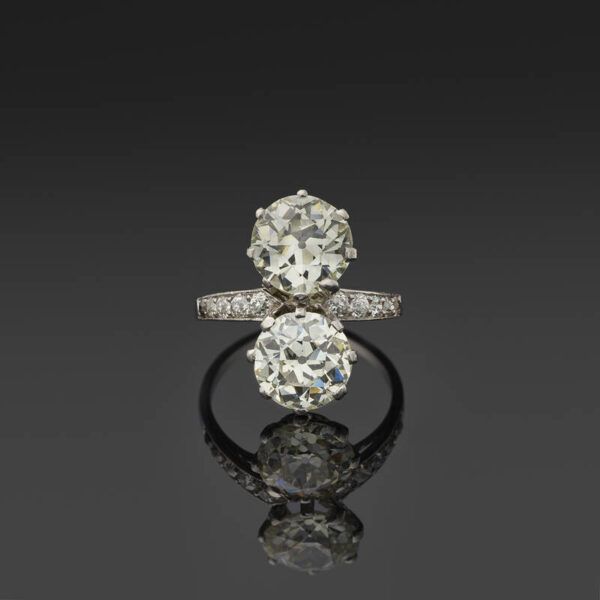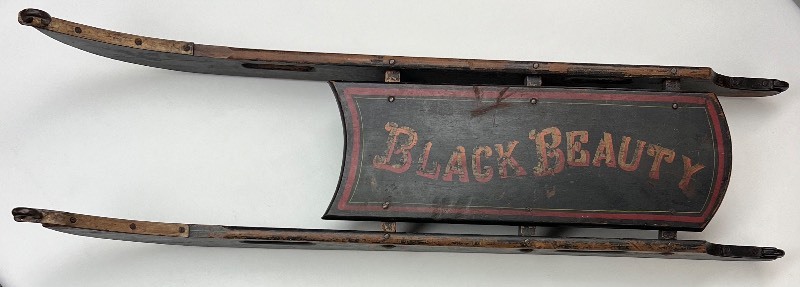#Hot #Lots #Coming #Auction #February #WorthPoint
WorthPoint’s Industry Partners are offering fantastic items in these February auctions, ranging from a romantic ring style made famous by a French emperor to an antique iron that historians compared to pressing clothes with a fire bomb.
Not only was Napoleon Bonaparte a great military strategist, but the man also had a good eye for baubles. When he proposed to Joséphine de Beauharnais in 1796, he gave her a yellow-gold engagement ring featuring a pear-cut blue sapphire nestled with a matching pear-cut diamond.
Known as a “Toi et Moi” (French for “you and me”) or “Moi et Toi” ring, it’s a shining symbol of two souls bound together by love and has been gracing fingers for centuries since he set the trend. They are one of the most popular and timeless engagement ring styles today and come in various designs and price points. Josephine’s ring sold for $948,000 in 2013.
Just in time for Valentine’s Day (and one of the most popular days to propose) is lot 289 in Rago Auctions’s live Jewels XOXO sale on February 7 in Lambertville, New Jersey. This Moi et Toi ring is in a classic Edwardian design, featuring European-cut diamonds set in platinum. It will add a beautiful sparkle to the hand of the woman who says “yes.”
The instant I saw lot 5A that Auction Studios of Medina, Minnesota, is offering in its All Things Unique, Fun & Wonderful sale closing on February 7, I was transported back to the carefree winter days of my childhood and the hours I spent tobogganing down snowy hills. No doubt the kid who once had this Victorian “Black Beauty” painted wooden sled also had plenty of winter fun with it.
Nostalgia makes hand-painted sleds popular with collectors, who acquire them as art pieces. By the 1840s in America, downhill coasting sleds were being manufactured for recreation, including Black Beauty, which had different painted designs and was one of the top models. It originally sold for $2. The fancier the sled’s decoration, the more collectors desire it, and the best examples are from the 1860s to 1890.
Bears are fearsome beasts to many, but to the Black Forest carvers of the 19th century, they were inspirations for fanciful creations. In Blackwell Auctions’s online and in-person February Exceptional Estates Auction closing February 10 in Clearwater, Florida, lot 4 is a classic example. The antique carved bear holds a bowl in one paw and a shell-shaped tray in the other and was initially used for calling cards.
Black Forest carvings originated in the early 19th century in the small mountain town of Brienz, Switzerland. These whimsical sculptures were inspired by nature and depict foliage, trees, and various forest animals. Bears are the most common and were humorously portrayed as reading books, skiing, or smoking pipes.
These delightful carvings, which include benches, chairs, clocks, hall trees, lamps, and umbrella stands, are prized by collectors today as decorative objects and essential examples of fine folk art and woodcarving.
Outside of comic books and Marvel movies, I don’t think we see enough capes these days. I propose we bring them back, especially ones like lot 238 in Augusta Auctions’s Vintage for Valentines sale on February 14.
The Bellows Falls, Vermont, auction house—which specializes in vintage and couture fashion—is offering several capes in the sale, but I love the drama of this two-piece circa-1800 pink shot silk domino cape, perfect for a clandestine midnight rendezvous.
These robe-like costume domino capes with large hoods and wide sleeves date to the masquerade balls of the 18th century but were sometimes worn at fancy dress balls. They needed to be large and long enough to slip easily over a gown and completely hide it.
Capes aren’t just for superheroes. They’re also for bold, stylish women who want to be caped couture crusaders.
Circus memorabilia collectors: step right up and behold the offerings at the annual Circus Memorabilia Mega Auction on February 17 at Freedom Auctions of Sarasota, Florida. Among the artifacts is lot 78L, a rare 1924 poster of Lillian Leitzel, hailed as “The World’s Most Marvelous Gymnast.”
The German-born aerialist Leitzel (1892–1931) was a star in the Ringling Bros and Barnum & Bailey Circus and mesmerized audiences with her acrobatic performances on Roman rings fifty feet in the air without a net. She commanded top billing longer than any other circus performer in history. Leitzel tragically died in 1931, two days after she fell more than twenty feet during a performance and landed on a concrete floor.
Collecting circus memorabilia remains a colorful and vibrant hobby. With their captivating images of animals and performers who dazzled audiences with their tricks and feats of derring-do under the Big Top, circus posters are especially popular and highly collectible.
As someone who reaches for the wrinkle-release spray far more than the iron, I had no idea how many different antique and vintage models have been invented for pressing clothes until I looked through the lots Hartzell’s Auction Gallery of Bangor, Pennsylvania, is offering in its online-only Irons in the Fire auction on February 18. The irons are from the collections of several members of the Pressing Iron and Trivet Collectors of America.
These domestic devices designed to press wrinkled fabric flat were made in many diverse models, including ones that posed a danger, like lot 22, an early liquid fuel iron. A liquid fuel like gasoline or kerosene was added to a canister to heat the iron base or added in a tank mounted on the iron to provide constant heat. These were used in the US in the late 19th century through World War II.
Some historians have said that using one of these models would be like ironing with a Molotov cocktail. They’re highly collectible, but no one likely uses them anymore to get the wrinkles out.
Adina K. Francis has been a writer and editor in the antiques and collectibles field for more than 20 years. She has a bit of an obsession with the Victorians and thinks that dogs are one of life’s greatest gifts.
WorthPoint—Discover. Value. Preserve.





